Turning Out Your Horse: To Boot or Not to Boot?
Updated December 9, 2022
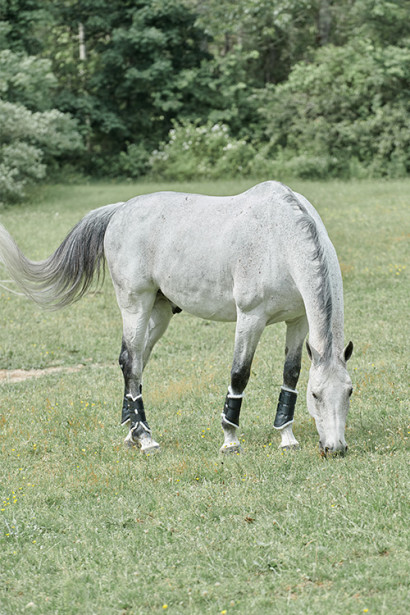
We all want to ensure our horses stay safe in turnout, and many people turn to boots and wraps to help protect their horses. The good (and maybe bad) news is that a wide variety of horse boots are available! We’ll explain the reasons for using horse boots, the differences between boot styles, and some things to keep in mind while shopping.
Should my Horse Wear Turnout Boots?
First, ask yourself why you’re putting turnout boots on your horse. You don't need to just put them on because everybody else at your barn is doing it.
Is your horse suddenly cutting up their legs in pasture? Or do you want to protect your investment before he gallops off after you’ve unclipped his lead rope? Maybe you simply want to keep your horse as clean as possible and prevent him from coming into the barn with his legs covered in dirt.
Reasons to use Turnout Boots
If you have a horse with tendon or ligament issues or who may be narrow set causing his legs to interfere with each other, then the protection turnout boots will offer can be beneficial. The purpose of boots on the legs is to protect against impact injury. Turnout boots may protect the cannon bone, splint bone, and soft tissues that run from the horse’s knee to fetlock.
Why is Your Horse Injuring Himself in Turnout?
If your horse has suddenly begun injuring himself while turned out, there are some questions you should ask yourself. He may have developed a medical issue that is affecting his way of going, balance, or perception. Something about his turnout may have changed (new horse, field, or hours), or something about the way he is kept in general has changed (different diet, workload, barn, or trainer).
Exercise Before Turnout
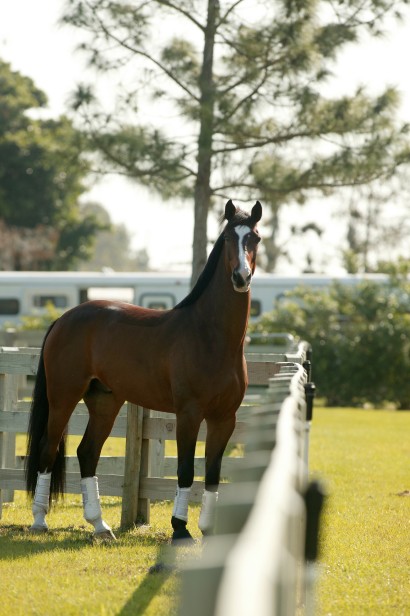
A study[1] measured horse behavior between three groups:
- two hours of turnout before training (TBT)
- two hours of turnout after training (TAT)
- training without turnout (NT)
While there were notable differences in under saddle performance and stalled behavior between the no turnout vs. turnout groups, researchers also observed that horses in the TBT group were significantly more active during turnout than horses in the TAT group. The take-home message for you—unless your horse is already on full turnout—is to try to work him before he gets turned out so he’s less rambunctious during free exercise, as long as he will be safe to ride when he’s “fresh.”
Paddock Size Matters
Another method for reducing injury during turnout is to either turn him out alone (but where he can still see other horses) or limit his partners to horses that don’t play rough or encourage him to run. You can also restrict him to a smaller paddock rather than a larger pasture so he can’t fully gallop.
His shoes could be another factor as bare feet may inflict less trauma than shod hooves.
Protect Your Horse’s Legs During Turnout
Now to actual protective wear, with the understanding that many times the decision regarding equine turnout protection is based on personal preference and trial-and-error.
Bell Boots for Turnout
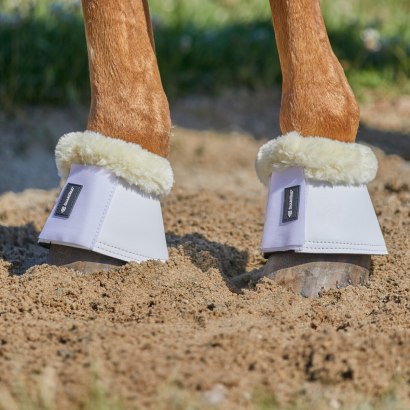
Starting at the bottom, many people like the safety that bell boots provide to coronary bands, heel bulbs, and other fragile structures on the lower limb. Bell boots are great options for horses who overreach, meaning their hind foot comes up and hits the heel of their front foot, causing them to pull their shoes or injure themselves. This is a very popular choice with or without turnout boots, and many horses wear them nearly all the time.
Some barns opt for the fuller coverage of standing wraps or polos; however, these are not appropriate leg protection for unobserved turnout because of the possibility of loosening, unrolling, or catching onto objects. An actual boot with closures is a safer choice for free exercise… but which one?
Types of Turnout Boots and Wraps
Since each type of boot has its own pros and cons (material, washability, breathability, etc.) we’ll leave it to you to experiment with what meets the needs of your horse and his human handlers best.
Brushing Boots for Turnout
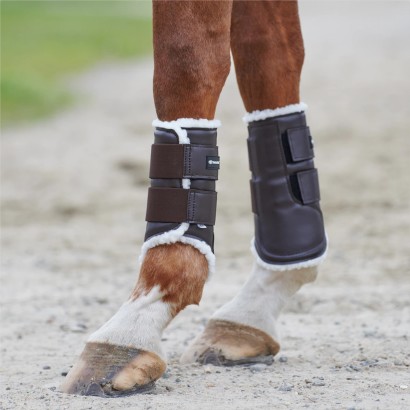
The terms brushing boots, splint boots, galloping boots, and sport boots are used interchangeably, meaning they’re the same kind of boots. They may be ergonomically designed to shape the horse’s legs and will have a strike guard on the inside to protect against impact, such as the horse knocking one leg against the other.
Turnout Boot Closures and Materials
Brushing boots can have a closed or open front. Closed-front boots offer more protection so they’re usually the go-to option for turnout. While open-front boots tend to be a more popular choice for riding.
Lots of boots are secured on the leg with sturdy Velcro straps which are easy to take on or off. Boots can be perforated or designed with air vents to allow moisture and heat to escape. Another option is fleece lining on the inside or the boot or portion of bell boot that sits along the pastern. Fleece is soft and comfortable and may be a great choice for horses with sensitive skin.
Sports Medicine Boots for Turnout

There are many different sports medicine-type model boots that cover the most exposed skin. However, they can be the trickiest to put on correctly, can get waterlogged, and tend to trap heat. When considering a sports medicine boot for turnout, look for one that’s designed to wick moisture, is lightweight, and has cooling textiles, like the Professional’s Choice 2XCool Sports Medicine Boots.
Sports medicine boots have a sling on the bottom that goes underneath the ankle. This boot helps protect against overuse injuries of the tendons and ligaments on the back of the leg by supporting the fetlock from sinking down too far or hyperextending.
Fitting and Cleaning Turnout Boots for Your Horse
If your horse is going to wear turnout boots, it’s crucial that they fit well and stay securely on. Turnout boots that are too loose can get dirt inside of them and cause sores or slip down and spook your horse or create more problems. So, boots can do harm if they’re not applied correctly, if they’re left on for too long, or if they’re dirty.
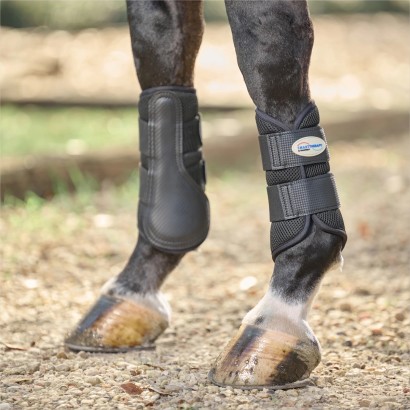
Along those lines, your boots need to be easy to clean and durable. Lots of turnout boots can easily be hosed off or thrown in the laundry. Make sure you read the boot’s care instructions and reattach the Velcro straps before putting them into the washing machine to save yourself from frustration later!
Sport boots need to hold up for daily use again, and again, and again. If your horse lives outside with bell boots on, remember to flip them or take them off every day to remove any trapped dirt or mud against the skin.
Brushing boots need to not hold water, and most importantly, not trap heat. There is some evidence that shows neoprene materials can hold or trap heat once a horse starts working. The soft tissues of the leg could get overheated, and therefore damage the cells. Manufacturers can counteract this by producing boots that wick moisture and regulate temperature. So, choose a turnout boot that’s breathable and moisture-wicking, especially if they’ll be in their paddock for a long time.
Turnout Boot Shopping Advice: Read the Reviews!
We all have different-sized horses; some with long or short legs and others with thick or thin legs. If you read the product descriptions and reviews, they’ll tell you about sizing, like if they’re true to size or if you should order a size larger or smaller than normal. You can learn if the boots are hard or easy to clean, and people’s general experiences with the products, too.
When it comes to buying turnout boots for your horse, we encourage you to first think about whether boots are necessary for your individual horse, and then think of ways that you could reduce your horse’s rambunctiousness during turnout. Finally, contact our product specialists for horse boot suggestions. They’re a team of real riders that may have some ideas based on what has worked best for their own horses!
References
- Werhahn, H., Hessel, E. F., Schulze, H., Van den Weghe, H. (2011). Temporary Turnout for Free Exercise in Groups: Effects on the Behavior of Competition Horses Housed in Single Stalls. Journal of Equine Veterinary Science, 31(7), 417-425.